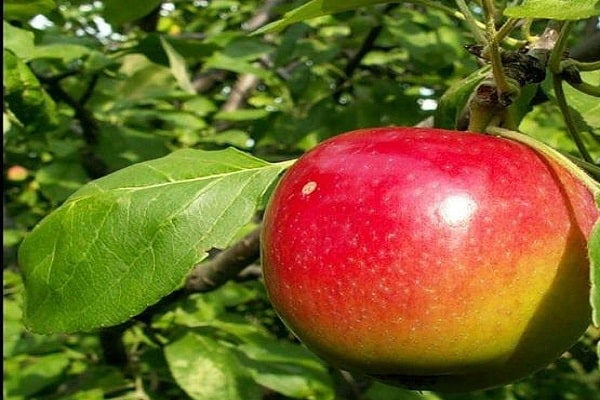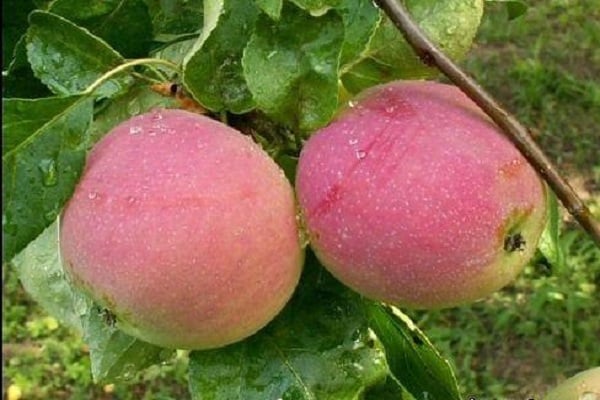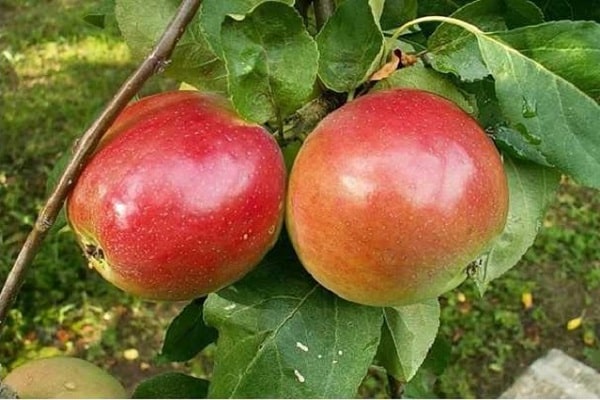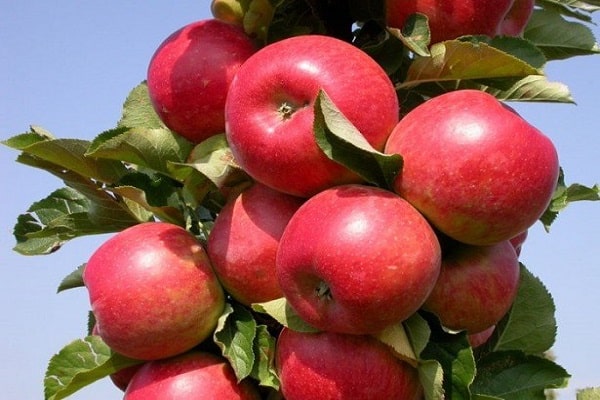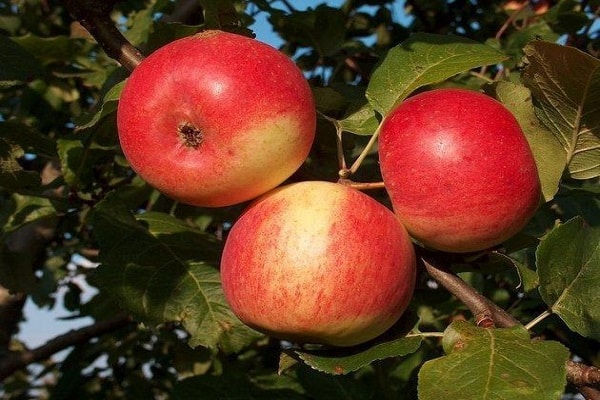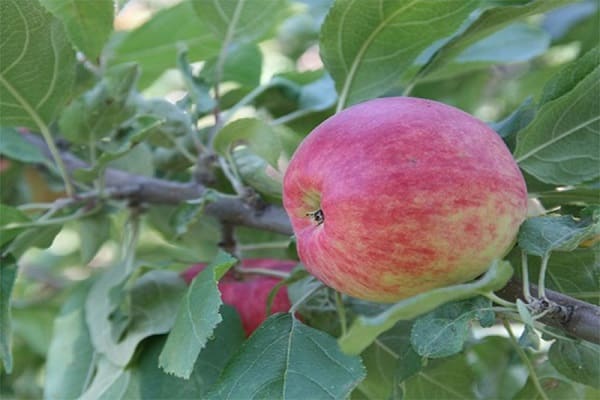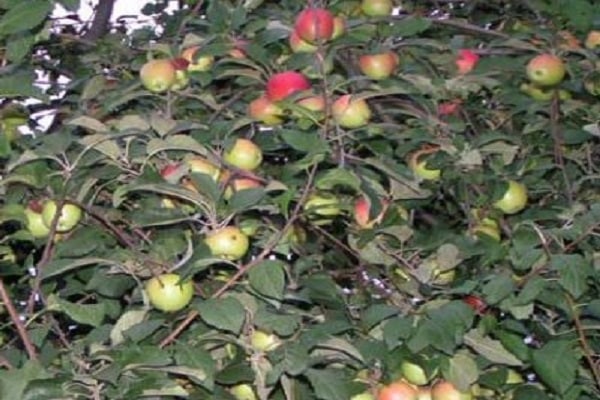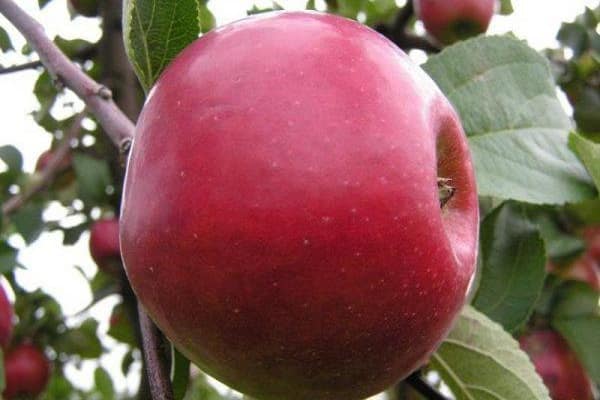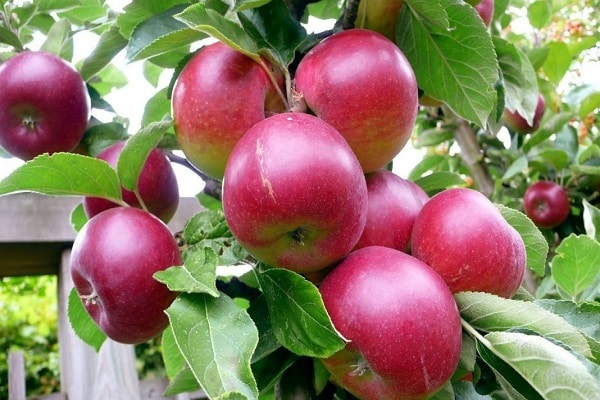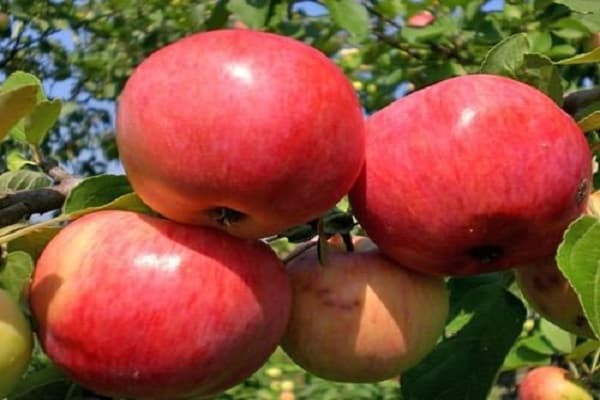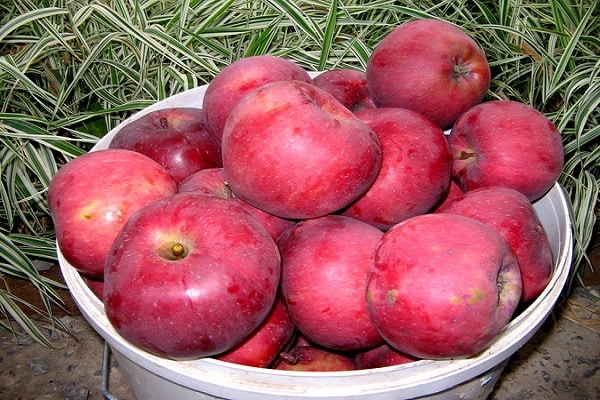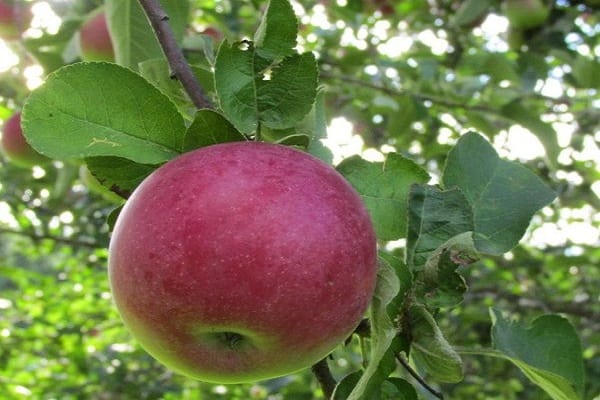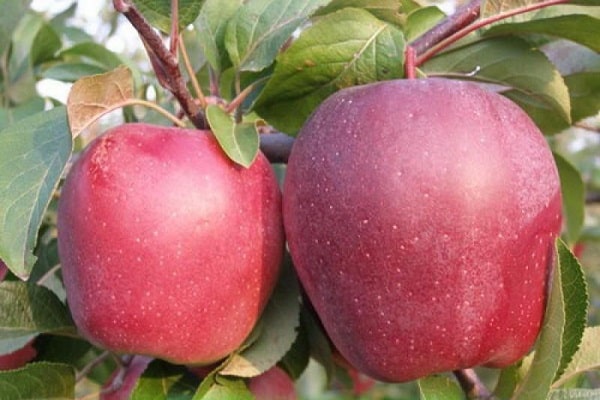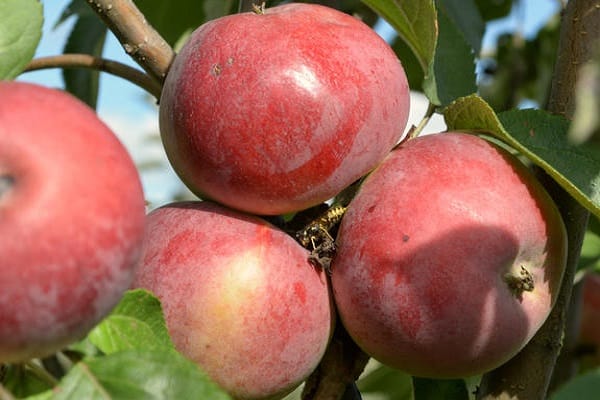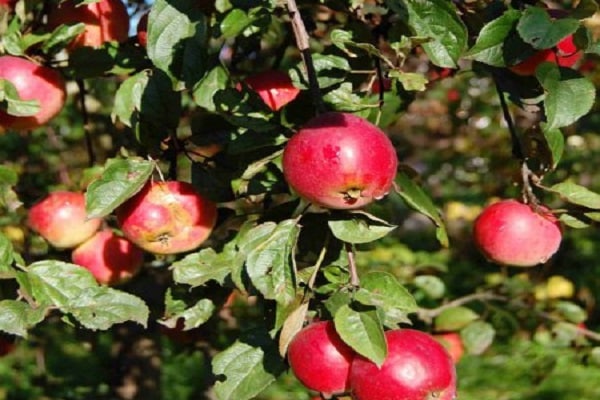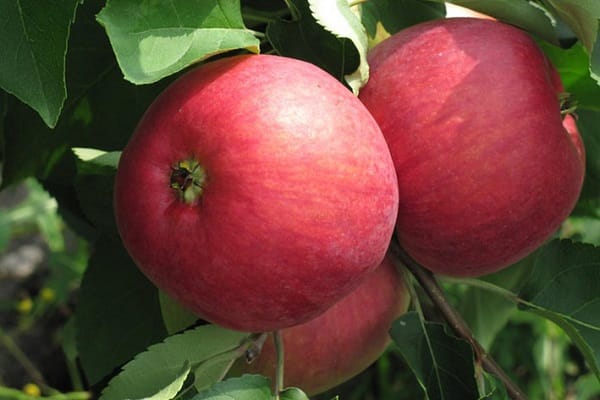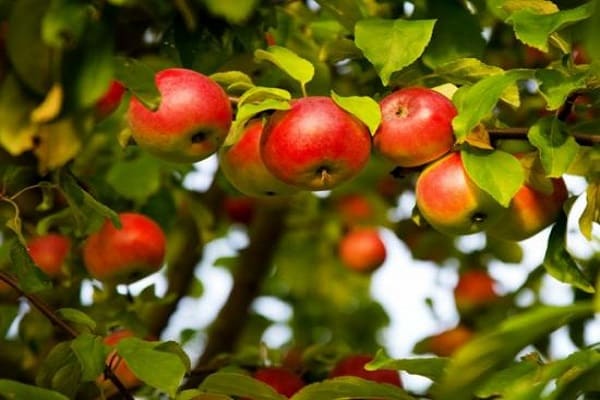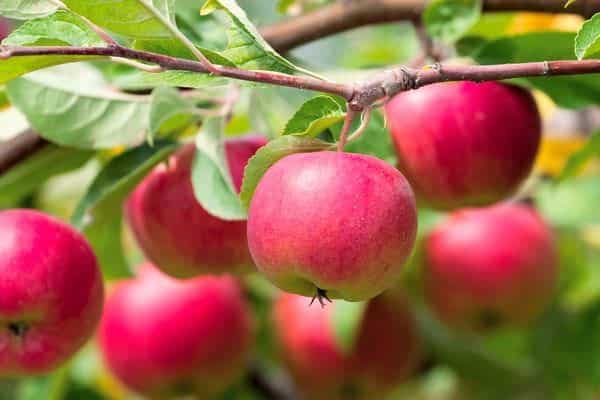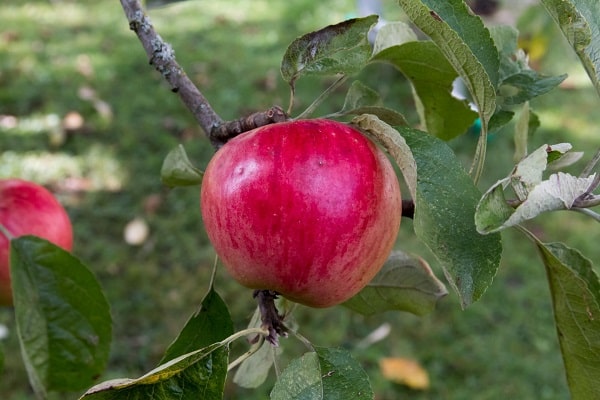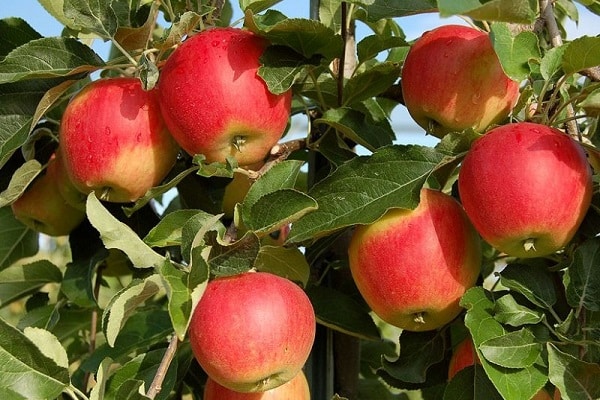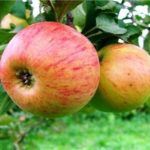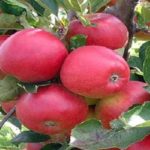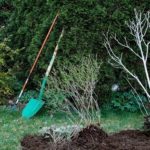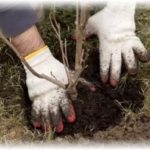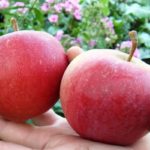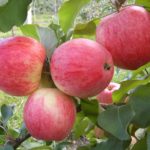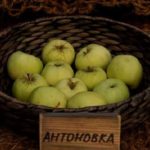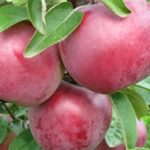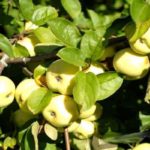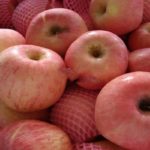An unpretentious apple tree of the Quinti variety that does not require special attention from the gardener generously provides fruits with high nutritional, biological and chemical value. In terms of taste, apples of the self-sterile variety are classified as table apples, not dessert ones. The variety was developed by Canadian breeders by crossing Crimson Beauty and Red Melba. In 1986, the plant was included in the state register of fruit trees for the Central Black Earth Region, the Caucasus, and the Lower Volga region.
- Variety overview
- Tree morphology
- Advantages and disadvantages
- Subspecies
- Early Queen
- Early ripe Quinti apple tree
- Characteristics of an apple tree
- Parameters of an adult tree
- Annual growth
- When does fruiting occur?
- Cold resistance
- Taste qualities of apples
- Content of useful and nutritious substances in apples
- Benefits and possible harm from eating Quinti apples
- Planting seedlings
- Preparing the soil for planting seedlings
- Map of marking the area for planting
- Setting the stage
- Dimensions of pit for seedlings
- Nuances when choosing seedlings
- When to plant
- Landing technology
- Agricultural technology
- Caring for the apple tree
- Trim and shape the crown
- What to do during flowering
- Watering trees
- Disease and pest control measures
- Recharge
- Pollinator varieties
- What you need to pay attention to when ripening and fruiting
- Features of growing on sandy soils
- Fruit collection
- Storage tips
- Moscow region
- Krasnodar region
Variety overview
The Quinti apple tree variety is a summer variety and does not have high shelf life. Has a high level of resistance to powdery mildew. It is not afraid of heat and drought, but the Quinti variety is not resistant to severe frosts.
Tree morphology
The tall trunk of the Quinti apple tree is almost hidden by dense foliage. The branches of a tree of this variety tend upward, and the skeletal branches extend from the trunk almost at a right angle. The crown is wide, oval, and not prone to thickening, which allows the rays of the sun to caress each fruit, no matter what tier of ringlets it is on.
The bark of the trunk and branches is brown with a greenish tint. Apple tree flowers are large white and have no other shades.
With abundant fruiting, the fruits do not exceed 125 g in weight; a small harvest suggests that the weight of each apple can be 175 g. The size and color of the fruits on one tree are the same. The apple has two types of color - green side and ruddy side.
Advantages and disadvantages
Pros:
- precociousness;
- resistance to heat and drought;
- high level of transportability.
Minuses:
- low winter hardiness;
- weak immunity to scab.
Subspecies
The difference between the subspecies of Quinti apple trees lies in the size of the fruits; the main characteristics of the variety remain practically unchanged.
Early Queen
A winter variety of the Quinti variety, bred in Holland. Technical maturity of the fruit occurs in the second ten days of October. The conical-round fruits reach a weight of 250 g. The green-yellow skin is evenly covered with a blurred blush of bright red color. Excellent presentation and high taste qualities of juicy sweet and sour pulp are the distinctive features of Early Queen, which has high frost resistance. Like its prototype, the variety is self-sterile. It requires self-fertile pollinating neighbors: Gala, Champion, Everest.
Early ripe Quinti apple tree
List of regions in which the Quinti apple tree harvest ripens earlier than in central Russia:
- Astrakhan;
- Vologda;
- Krasnodar region;
- Kursk;
- Lipetsk;
- Volga region;
- Rostov;
- North Ossetia.
Characteristics of an apple tree
To grow the Quinti variety in warm regions, low-growing apple trees on a dwarf rootstock are mainly used. It is easier to harvest from them, and their fruiting begins already the next season after planting in a permanent place.
Parameters of an adult tree
On the seed rootstock, the Quinti apple tree reaches 5 meters in height; on the dwarf rootstock, the top of its crown does not reach the 2-meter mark.
Pollination and flowering
The apple tree is pollinated by self-fertile apple trees with the same flowering periods as the Quinti variety. This explains the alternation of rows of the Quinti variety and other apple trees in large gardens. Without proximity to pollinating varieties, large white flowers will never set an ovary. Pollinators, like Quinty itself, should enter the flowering phase in early to mid-May.
Annual growth
On medium-sized apple trees of the Quinti variety, the skeletal branches lengthen by 5-6 cm over the season. On a dwarf rootstock, the tree a priori does not have a skeletal frame; they are columnar - the ringlets extend directly from the trunk. By the age of 5, the low-growing Quinti apple tree reaches its maximum height; the growth of ringlets largely depends on the amount of rain and sunny color. The length of the shoot is adjusted in the fall during pruning.
When does fruiting occur?
For the first time, the harvest from a medium-sized Quinti apple tree (on a seed rootstock) is harvested in the 5-6th season. From low-growing apple trees already in the second year. Fruiting is regular, not dependent on natural disasters. In warm climates, 2 harvests can be harvested from one tree per season. Typically, the fruits ripen by the end of July.
Cold resistance
The winter hardiness of the Quinti apple tree is average with proper care. The lack of measures to insulate the trunk and soil for winter reduces the plant's resistance to frostbite.
Protection from diseases and pests
The main enemy of Quinti apple trees is scab; the disease is caused by excessive waterlogging of the soil. If a gardener cannot prevent rains and floods, then anyone can create high-quality drainage at the time of planting a seedling.
The mandatory stages of measures to prevent fungal, bacterial and wood damage caused by insect pests are as follows:
- timely spraying of the tree with preventative doses of agents against scab and powdery mildew;
- high-quality soil mulching;
- loosening the soil within a radius of 1.5-2 meters from the trunk;
- applying foliar and root balanced fertilizers;
- whitewashing the trunk with lime with additions of copper-containing substances;
- systematic pruning of old shoots and damaged branches.
If the disease does occur, then prophylactic doses of drugs are replaced with stronger solutions, and treatments are carried out at intervals of 7-10 days.
Taste qualities of apples
Summer apples grown in sunny areas are juicy and sweet. Pleasant sourness gives the fruit a unique charm. The tasting assessment of the Quinti variety by specialists is 4.6 points out of 5 possible.
Content of useful and nutritious substances in apples
The fruits of the Quinti variety per 100 g contain:
- Ascorbic acid - 8.4-11.2 mg.
- Fiber (dry matter) - 15.9-16.8%.
- Acids - 0.53-0.6%.
- Fruit sugars - 10.3-11.2%.
Benefits and possible harm from eating Quinti apples
Like all apple fruits, Quinti is rich in vitamins and minerals. Nothing like apples replenishes iron in the body, which is necessary to normalize hemoglobin in the blood. Fiber improves metabolism, absorbs and removes toxins.
Sweet apples can be harmful for people prone to diabetes and for allergy sufferers who are contraindicated in eating red fruits.
Planting seedlings
The health of the plant and the quality of the harvest depend on the time of planting, the correct selection of seedlings grafted onto a certain type of rootstock, high-quality enrichment and soil preparation.
Preparing the soil for planting seedlings
The soil is dug up in the fall, weeds and rhizomes are pulled out of the turf, but the clods of earth are not broken, so that during a winter with little snow the earth does not turn into dust. Only part of the soil, which will be used to partially fill the planting hole, is thoroughly loosened.This soil will be mixed with nutrients - humus, manure, peat, ash and complex root nutrition used to improve soil fertility in the region where the seedlings are planted.
Map of marking the area for planting
It is necessary to maintain a 5-meter interval between seedlings with the skeletal structure of a tree, both in the row between Quinti seedlings and in the rows with neighboring pollinating apple trees.
Setting the stage
The soil for planting a medium-sized tree should be dense, but permeable to water and air. On sandy loams, where clay rather than sand predominates, the soil should be loosened by adding sand and ash to the area. Gardeners will follow the same procedure if it is necessary to reduce soil acidity.
Sandy, loose soils are extremely difficult to strengthen; in order to grow good crops on them, you have to prepare for the systematic replenishment of the soil with minerals, nitrogen and other useful substances.
Dimensions of pit for seedlings
For a medium-sized plant, the width and depth of the planting hole for Quinti apple trees is 1.5 m, width - 2 m. For low-growing plants on a semi-dwarf rootstock, the width of the hole can be smaller, as for seedlings with a closed root system - 1 meter wide and the same in depth.
Nuances when choosing seedlings
When choosing seedlings, you need to pay attention to the presence of a grafting stem. Its absence indicates that the gardener is facing a wild escape. The rhizome should not have any damage; if this is not the case, the tree will be sick, and more seasons will pass before the first harvest than indicated in the description of the variety.
When to plant
In regions with a favorable, mild climate, Quinti can be planted in the spring when warm weather sets in, when the ground has moved away from freezing.The tree will take root well in properly prepared soil. For areas of the middle zone - Moscow, the North-West, the Leningrad region, autumn planting is recommended after the snow melts and positive average daily temperatures have established.
Landing technology
A pit with a drainage, nutrient and regular layer of soil is prepared in the fall, regardless of the expected planting time. A seedling is placed on an improvised mound, where the top layer of soil is ordinary, not enriched, and its roots are evenly distributed throughout the hole. A seedling of a low-growing tree will need support; before lowering it onto a prepared earthen bed, a stake must be driven into the middle of the hole. A seedling will be tied to it.
Agricultural technology
The complex of tree care - agricultural technology, consists of the methodical implementation of all stages of activities aimed at obtaining a healthy tree and a large harvest.
Caring for the apple tree
Caring for an apple tree begins even before it is planted. To strengthen the root system and provoke rapid plant growth in the first season, the root system is immersed in a solution of a growth stimulator for 24 hours.
Trim and shape the crown
Shoots that have lengthened by more than 60 cm over the summer period must be shortened. Considering that the crown of the Quinti variety is round in shape, it must be adhered to when pruning skeletal branches; the lower ones should be slightly longer than each subsequent tier.
What to do during flowering
To strengthen the flowers on the branches and increase their strength for the formation of ovaries, it is necessary to saturate the soil with nitrogen. Leafworms, mites and other insects will want to feast on fresh foliage, which means that at the stage of bud formation it is necessary to spray against pests.
Watering trees
The need for additional irrigation depends entirely on the climatic and geographical characteristics of the area. Apple trees growing in sunny, arid regions need to be watered once a week at the rate of 10 liters of water per meter of tree height. In areas with periodic rains, watering is carried out during prolonged dehydration of the soil.
Disease and pest control measures
Insecticides are used against insects; spraying with them for preventive purposes is carried out before the buds open and the flowering phase begins. They will help from:
- flower beetle;
- codling moths;
- Californian scale insect;
- sawfly;
- red fruit mite;
- green apple aphid;
- five types of leaf rollers;
- American white butterfly;
- apple moth.
If damage to the tree by insects or diseases does occur, then the damaged areas of the tree must be cut and burned, the cut areas should be treated with garden varnish, and the tree should be treated with a strong solution of Bordeaux mixture and fungicides. To prevent relapse, spraying with prophylactic doses of the compositions is carried out at intervals of 7-10 days.
Recharge
When enriching soils, it is necessary to use manure and guano with extreme caution; organic matter is a favorable environment for the wintering of insect pests and the proliferation of pathogenic microflora, which causes bacterial damage to bark, wood, and fruits.
Pollinator varieties
There are no special recommendations for pollinating varieties; the main thing is that the variety planted in the neighborhood is self-fertile, and its flowering dates coincide as closely as possible with Quinti.
What you need to pay attention to when ripening and fruiting
Green-brown spots appearing on the leaves are a sign of scab, to which Quinti apple trees have extremely weak immunity.Scab develops quite quickly, affecting foliage and fruits, so it is necessary to act without delay - thin the crown, remove and destroy the affected branches, carry out therapeutic spraying, add potassium fertilizer to the soil.
Features of growing on sandy soils
To preserve the nitrogen introduced into the soil through irrigation and to strengthen the soil, the tree trunk space is sown with grass, mainly thistle. Its long roots will bind the sandy soil. To saturate the soil with substances useful for the development of the Quinti apple tree, humus mixed with sand and humus is introduced under the roots into the planting hole.
What you need to know about the harvest
You can collect up to 120 kg of apples from one tree; they ripen at the same time, but it will not be possible to store them for more than 3 weeks, even if collected at the stage of technical, rather than consumer, maturity. Transportability of the fruits is low.
Fruit collection
Apples must be picked directly from the branches; fallen apples will not last even three days.
Storage tips
The optimal temperature for storing Quinti apples is from 0 to +10 °C. Each fruit must be isolated from its neighbors, but at the same time the air flow must be open to it; this condition can be achieved by wrapping it in newspaper, food tracing paper, or tissue paper.
It is better to store wrapped apples not in wooden, but in plastic boxes; they do not contain rot pathogens or other pathogenic microflora.
Using apples in cooking and farming
Sweet apples are an excellent raw material for making jams, preserves, and compotes with minimal added sugar. Dried apples are an excellent raw material for making compotes. Considering that they can only be stored in canvas bags, they will also add a summer aroma to the room.
Regional cultivation
The timing of flowering, fruiting and the quality of the harvest - the balance of sugars and acids - depend on the climatic characteristics of the region.
Moscow region
For the Moscow region, the typical time for planting Quinti apple trees is in mid-October - a month before the onset of the first frost. Taking into account the soil moisture and the possibility of close occurrence of aquifers, the drainage layer in the planting hole should occupy at least 60 cm.
Krasnodar region
A region with fertile soils does not require a large amount of fertilizing for apple trees of the variety and all subspecies of Quinti in the spring months, but if the apple tree bears fruit twice a season, it will require a large amount of nitrogen; it should be applied as foliar feeding after the first harvest.

